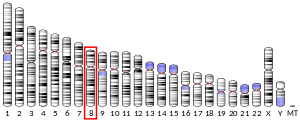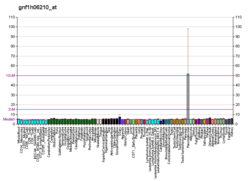Zinc transporter 8
Zinc transporter 8 (ZNT8) is a protein that in humans is encoded by the SLC30A8 gene.[5] ZNT8 is a zinc transporter related to insulin secretion in humans. Certain alleles of the SLC30A8 gene may increase the risk for developing type 2 diabetes, but a loss-of-function mutation appears to greatly reduce the risk of diabetes.[6]
Clinical significance
Association with type 2 diabetes (T2D)
Twelve rare variants in SLC30A8 have been identified through the sequencing or genotyping of approximately 150,000 individuals from 5 different ancestry groups. SLC30A8 contains a common variant (p.Trp325Arg), which is associated with T2D risk and levels of glucose and proinsulin.[7][8][9] Individuals carrying protein-truncating variants collectively had 65% reduced risk of T2D. Additionally, non-diabetic individuals from Iceland harboring a frameshift variant p. Lys34Serfs*50 demonstrated reduced glucose levels.[6] Earlier functional studies of SLC30A8 suggested that reduced zinc transport increased T2D risk.[10][11] Conversely, loss-of-function mutations in humans indicate that SLC30A8 haploinsufficiency protects against T2D. Therefore, ZnT8 inhibition can serve as a therapeutic strategy in preventing T2D.[6]
See also
- Solute carrier family
References
- GRCh38: Ensembl release 89: ENSG00000164756 - Ensembl, May 2017
- GRCm38: Ensembl release 89: ENSMUSG00000022315 - Ensembl, May 2017
- "Human PubMed Reference:". National Center for Biotechnology Information, U.S. National Library of Medicine.
- "Mouse PubMed Reference:". National Center for Biotechnology Information, U.S. National Library of Medicine.
- "Entrez Gene: SLC30A8 solute carrier family 30 (zinc transporter), member 8".
- Flannick, Jason; et al. (2014). "Loss-of-function mutations in SLC30A8 protect against type 2 diabetes". Nature Genetics. 46 (4): 357–363. doi:10.1038/ng.2915. PMC 4051628. PMID 24584071.
- Dupis, J.; et al. (Feb 2010). "New genetic loci implicated in fasting glucose homeostasis and their impact on type 2 diabetes risk". Nature Genetics. 42 (2): 105–16. doi:10.1038/ng.520. PMC 3018764. PMID 20081858.
- Strawbridge, R.J.; et al. (October 2011). "Genome-wide association identifies nine common variants associated with fasting proinsulin levels and provides new insights into the pathophysiology of type 2 diabetes". Diabetes. 60 (10): 2624–34. doi:10.2337/db11-0415. PMC 3178302. PMID 21873549.
- Morris, A.P.; et al. (Sep 2012). "Large-scale association analysis provides insights into the genetic architecture and pathophysiology of type 2 diabetes". Nature Genetics. 44 (9): 981–90. doi:10.1038/ng.2383. PMC 3442244. PMID 22885922.
- Nicolson, T.J.; et al. (Sep 2009). "Insulin storage and glucose homeostasis in mice null for the granule zinc transporter ZnT8 and studies of the type 2 diabetes–associated variants". Diabetes. 58 (9): 2070–83. doi:10.2337/db09-0551. PMC 2731533. PMID 19542200.
- Rutter, G.A.; et al. (2010). "Think zinc: new roles for zinc in the control of insulin secretion". Islets. 2 (1): 49–50. doi:10.4161/isl.2.1.10259. PMID 21099294.
Further reading
- Chimienti F, Favier A, Seve M (2006). "ZnT-8, a pancreatic beta-cell-specific zinc transporter". Biometals. 18 (4): 313–7. doi:10.1007/s10534-005-3687-9. PMID 16158222.
- Hartley JL, Temple GF, Brasch MA (2001). "DNA cloning using in vitro site-specific recombination". Genome Res. 10 (11): 1788–95. doi:10.1101/gr.143000. PMC 310948. PMID 11076863.
- Wiemann S, Weil B, Wellenreuther R, et al. (2001). "Toward a catalog of human genes and proteins: sequencing and analysis of 500 novel complete protein coding human cDNAs". Genome Res. 11 (3): 422–35. doi:10.1101/gr.GR1547R. PMC 311072. PMID 11230166.
- Strausberg RL, Feingold EA, Grouse LH, et al. (2003). "Generation and initial analysis of more than 15,000 full-length human and mouse cDNA sequences". Proc. Natl. Acad. Sci. U.S.A. 99 (26): 16899–903. doi:10.1073/pnas.242603899. PMC 139241. PMID 12477932.
- Seve M, Chimienti F, Devergnas S, Favier A (2004). "In silico identification and expression of SLC30 family genes: an expressed sequence tag data mining strategy for the characterization of zinc transporters' tissue expression". BMC Genomics. 5 (1): 32. doi:10.1186/1471-2164-5-32. PMC 428573. PMID 15154973.
- Chimienti F, Devergnas S, Favier A, Seve M (2004). "Identification and cloning of a beta-cell-specific zinc transporter, ZnT-8, localized into insulin secretory granules". Diabetes. 53 (9): 2330–7. doi:10.2337/diabetes.53.9.2330. PMID 15331542.
- Gerhard DS, Wagner L, Feingold EA, et al. (2004). "The status, quality, and expansion of the NIH full-length cDNA project: the Mammalian Gene Collection (MGC)". Genome Res. 14 (10B): 2121–7. doi:10.1101/gr.2596504. PMC 528928. PMID 15489334.
- Wiemann S, Arlt D, Huber W, et al. (2004). "From ORFeome to biology: a functional genomics pipeline". Genome Res. 14 (10B): 2136–44. doi:10.1101/gr.2576704. PMC 528930. PMID 15489336.
- Mehrle A, Rosenfelder H, Schupp I, et al. (2006). "The LIFEdb database in 2006". Nucleic Acids Res. 34 (Database issue): D415–8. doi:10.1093/nar/gkj139. PMC 1347501. PMID 16381901.
- Sladek R, Rocheleau G, Rung J, et al. (2007). "A genome-wide association study identifies novel risk loci for type 2 diabetes". Nature. 445 (7130): 881–5. doi:10.1038/nature05616. PMID 17293876.
- Wenzlau JM, Juhl K, Yu L, et al. (2007). "The cation efflux transporter ZnT8 (Slc30A8) is a major autoantigen in human type 1 diabetes". Proc. Natl. Acad. Sci. U.S.A. 104 (43): 17040–5. doi:10.1073/pnas.0705894104. PMC 2040407. PMID 17942684.




